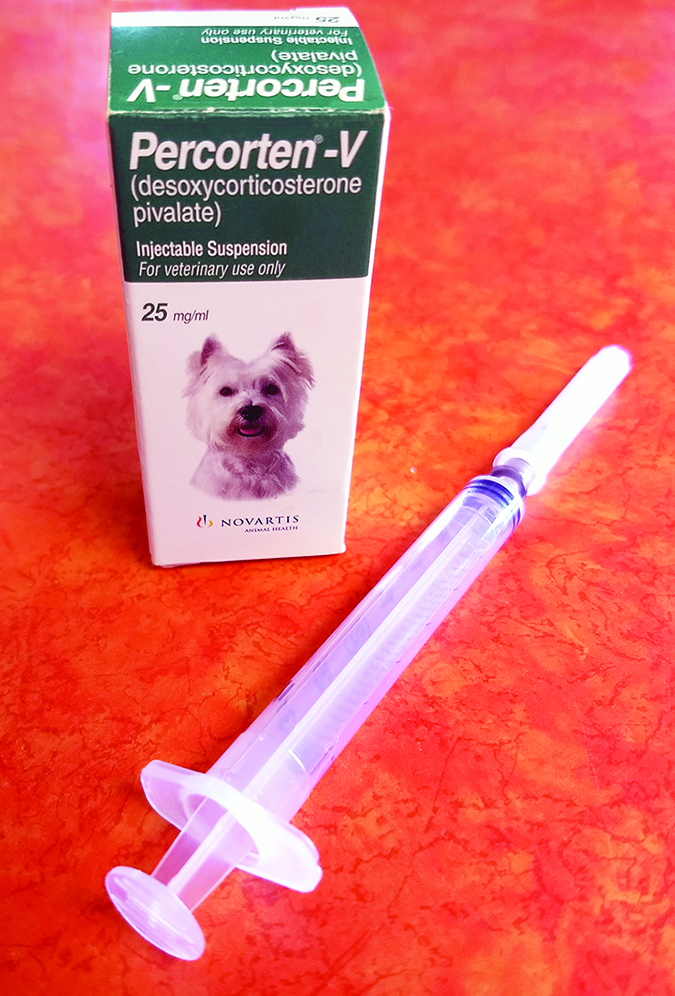Addison’s disease is often called the “great pretender.” The symptoms can be chronic, vague, and masquerade as other illnesses. The initial diagnosis is often missed and only discovered after other diagnostic avenues have been exhausted. In any dog that has waxing and waning signs like decreased appetite, weight loss, diarrhea, vomiting, or just general “poor doing,” Addison’s should be on the differential diagnosis list. This is especially true in breeds such as Rottweilers, Great Pyrenees, and Portuguese Water Dogs.
Addison’s Disease and the Endocrine System
The medically descriptive name for Addison’s disease is hypoadrenocorticism, referring to inadequate adrenal gland secretion.
The adrenal glands are part of the very complex endocrine system, which is a chemical messenger system that helps regulate and modulate the function of the dog’s organs.
The endocrine system begins in the brain, at the hypothalamic axis. The brain releases chemical signals, which, in turn, start a cascade of other actions. The brain secretes corticotropin-releasing hormone (CRH), which stimulates the pituitary gland to secrete adrenocorticotropin hormone (ACTH), which normally stimulates the adrenal glands to make and release cortisol hormones into the blood.
The small, peanut-shaped adrenal glands are positioned just above the kidneys. They are divided into two areas: the cortex (outside) and the medulla (inside). Each part releases different substances when cued to do so by the ACTH.
The adrenal medulla produces catecholamines, including adrenaline, norepinephrine, and small amounts of dopamine. These hormones are responsible for all the physiological characteristics of the so-called “fight or flight” response.
The adrenal cortex produces a variety of steroidal hormones, including mineralocorticoids (which help maintain electrolyte balance and blood pressure) and glucocorticoids (including cortisol, which helps regulate body metabolism). Without these hormones, all sorts of body functions will go awry.
How Addison’s Disease Develops in Dogs
Addison’s disease occurs when the adrenal glands or brain axis are not functioning properly. It can be divided into two categories: primary and secondary.
In primary Addison’s disease, the problem is the adrenal glands themselves. In the case of 75 to 95 percent of Addisonian dogs, the problem begins when the immune system damages the adrenal glands so that they can no longer release their important hormones In a small subset, only the glucocorticoids are affected. This is called atypical Addison’s.
Secondary hypoadrenocorticism occurs at the level of the brain. Trauma, infection, inflammation, and cancer can all cause abnormalities in the axis. These cases are not common. A much more likely cause of secondary Addison’s disease is when a dog has been given steroids long-term for problems like allergies or autoimmune disease, and the steroids are suddenly withdrawn.
When a dog is given supplemental steroids, the body downregulates its own production of these steroids. When the supplemental steroids are stopped suddenly, the body does not have time to adjust and produce more. This causes a crisis, but it is not permanent. This reaction is why long-term steroids must always be weaned slowly.
Symptoms and Diagnosis of Addison’s Disease in Dogs
The symptoms of Addison’s disease can be insidious and chronic. A dog will have episodes of gastrointestinal upset with or without weight loss. Sometimes weight loss is the only sign, or there are very few symptoms other than occasional listlessness. It is easy for these to go unnoticed.
These vague symptoms are why many dogs are diagnosed only when they experience an Addisonian crisis. In this case, the lack of steroids and/or mineralocorticoids causes an acute, life-threatening collapse with severe electrolyte imbalances, dehydration, and gastrointestinal disease. A dog may seem normal then suddenly start vomiting, experiencing bloody diarrhea, and collapse. This is an emergency. The signs are not specific to Addison’s disease and can represent other conditions such as anaphylaxis or acute hemorrhagic gastroenteritis; these conditions, too, call for emergency medical care.
The diagnosis of an Addisonian crisis is made based on clinical signs, history, signalment (age, breed, and sex), a physical exam, and bloodwork. Typical Addison’s disease causes highly characteristic changes found on the dog’s blood tests. Electrolyte changes are present including very elevated blood potassium in conjunction with a low sodium level. A sodium:potassium ratio should be evaluated by your veterinarian. A ratio of less than 27:1 often indicates Addison’s.
Other changes can include low blood sugar (hypoglycemia), mildly elevated kidney values, and a normal white blood cell count in the face of illness. In an ill or stressed dog, the white blood cell count should be elevated, indicating a bodily response. However, in Addisonian patients, this doesn’t occur. It’s important to know that these changes are in typical hypoadrenocorticism, in which both cortisol and mineralocorticoid levels are low.
In atypical Addison’s, only cortisol is involved. Bloodwork may be mostly normal. Electrolytes will not be affected. Sometimes the only change is a low blood sugar and a lack of elevation in white blood cells. This makes recognition and diagnosis a challenge.
The definitive test for both typical and atypical is the ACTH stimulation test. In a patient with Addison’s disease, the glands cannot secrete cortisol and mineralocorticoid because they are not functioning or are atrophied.
The patient must stay at the veterinary clinic for several hours while the test is administered. An initial baseline cortisol level is drawn. This is typically very low in Addisonian patients. The dog is then given an injection of substance that mimics ACTH in an effort to stimulate the adrenal glands; the cortisol levels are checked two hours later.
In a patient with hypoadrenocorticism, the adrenal glands do not respond and the “post-cortisol” level is close to zero, confirming the diagnosis. Note that the blood samples for this test must be sent to an outside laboratory; this is not an in-house test.
Addison’s Disease Treatment for Dogs
Initial treatment will depend on whether a dog is typical or atypical and on the severity of the condition at presentation.
If a dog is diagnosed while stable, initial treatment is with oral steroids, usually prednisone. This is true for both typical (deficiencies in cortisol and mineralocorticoids) and atypical (deficiency of just steroids). Due to the many side effects they can cause, therapeutic steroid dosages should be adjusted over time to the lowest possible dose.

If a dog is atypical, steroids are usually sufficient treatment. It is important to note that some dogs who initially present with atypical Addison’s will progress to the more typical disease, eventually requiring the mineralocorticoid supplementation, as well.
There are currently two options for this: an oral supplement (fludrocortisone acetate) and an injectable one (desoxycorticosterone pivalate, better known as DOCP).
Fludrocortisone acetate, the less expensive choice, is given daily. It has both mineralocorticoid activity and some steroid activity, so certain patients can be maintained on fludrocortisone only. However, monitoring is more intense for the first 18 to 24 months, and in some cases, it just doesn’t work well enough. The side effects of the glucocorticoid portion can also be very intense at higher doses (increased drinking, increased urination, panting, weight gain, and restlessness).
The better alternative is DOCP, given as an injection every 25 to 30 days. This is by far the preferred treatment option because of the long duration between injections and how well it works. With veterinary instruction, it can be administered at home. However, DOCP can be very expensive for big dogs. Also, it is intermittently unavailable, so in those cases, fludrocortisone acetate may be chosen as the initial treatment.
The treatment is different for a dog who is diagnosed due to an Addisonian crisis – unfortunately, this is not uncommon. A previously healthy dog may suddenly develop copious vomiting, hemorrhagic diarrhea, shock, and collapse. This is an emergency and requires immediate veterinary attention. Dogs are usually suffering low blood pressure, low blood sugar, and seriously unbalanced electrolyte levels.
Large volumes of intravenous fluids will correct low blood pressure and electrolyte abnormalities. A physiologic dose of a short-acting steroid (Dexamethasone-SP) is given. This will not interfere with necessary testing to confirm the diagnosis (while other, longer acting steroids will). Blood sugar is often low during a crisis and should be treated as well. Dextrose will be added to the fluids.
Patients will be in the hospital anywhere from two to five days, depending on the severity of shock and electrolyte imbalances. Serial bloodwork is performed to monitor sodium and potassium, as well as blood glucose. Electrolytes may be checked as frequently as every four hours in the initial 24- to 48-hour period. Blood pressure is monitored closely. Treating an Addisonian crisis can be costly and stressful, and the prognosis is always guarded.
Monitoring Dogs with Addison’s
Once stable, dogs with hypoadrenocorticism must be monitored closely at home. Symptoms of impending crisis can be as subtle as shaking but also may include vomiting, loose stool, decreased appetite, and weakness. Any time a stressful event occurs and the body naturally requires more cortisol, a dog is at risk for a crisis. Ask your veterinarian for information about increasing steroids in these times.
Serial bloodwork is needed to titrate treatment. This usually includes electrolyte monitoring, as well as periodically checking a full blood panel. Electrolytes are usually checked every three to six months initially; once they have normalized, the tests can be less frequent.
A full metabolic panel is recommended every six months. When a patient is maintaining well on DOCP, the dose is usually sufficient to manage symptoms for the rest of the animal’s life.
A Note About Whipworms
The canine whipworm, Trichuris vulpis, is a nasty parasite that lives in the large intestine. The symptoms of a whipworm infection can be very similar to Addison’s disease and include weight loss, vomiting, and bloody diarrhea. Further, they can cause the characteristic bloodwork changes of Addison’s, particularly the telltale sodium:potassium ratio.
If you are in an endemic area (ask your veterinarian, or see the informative prevalence maps at capcvet.org/maps), keep your dog on a monthly prevention that protects against whipworms. Sentinel, Trifexis, Interceptor Plus, and Advantage Multi all contain ingredients that treat whipworm infections. Check the label or product insert on your dog’s flea/tick and heartworm preventatives to see if they contain an agent that specifically targets whipworms.
A Pitch for Pet Insurance
Health insurance for dogs is always a good idea, but even more so if your dog is diagnosed with a chronic illness such as Addison’s disease. Since it is such an excellent mimic, it make take several lab tests before the correct diagnosis is made. Even if the diagnosis is made quickly, follow-up testing, medications, and monitoring can quickly add up (no pun intended).
Most pet insurances decline coverage for pre-existing conditions. With a diagnosis of Addison’s disease, it is likely too late to find a company that will pay for diagnostics and treatment. If your dog was insured beforehand, however, insurance can be a literal lifesaver.
As a veterinarian, I wish more owners would consider pet insurance. Making a diagnosis under even the best of circumstances with unlimited funds can be challenging. It is even more so when finances are a major factor. Of all the chronic diseases, Addison’s is one of the most easily treated and managed. Unfortunately, the cost of diagnosing, treating, and monitoring can be a burden, and sometimes hard decisions must be made. “Financial euthanasia” can be especially traumatic for everyone involved.
Dogs with Addison’s disease can be tricky to diagnose, time-consuming, and test-intensive in the initial stages. Pet insurance can alleviate this strain dramatically. In this situation, we all win: the veterinarian, the pet owner, but mostly importantly, the patient!
Addison’s Disease Prognosis
Treatment is lifelong, but the prognosis for Addison’s disease is positive overall. The limiting factor for many dog owners is the cost of repeated laboratory testing in the first 12 to 18 months. DOCP also can be expensive for large dogs. Once the disease is stabilized, however, dogs often enjoy a good quality of life with minimal follow-up testing and less expense.
After nine years in emergency medicine, Catherine Ashe, DVM, now works as a relief veterinarian in Asheville, NC.







My dog was just diagnosed with Addison’s on April 6, 2019 so I’ve been reading everything I can. Thanks for a useful and timely article!
Carolyn M join the Addison’s group on fb you will learn so much more, everyone is wonderful and there are vets in the group as well. Good luck
Donna
Hi Carolyn M, My 13.5 year old female Boston terrier was diagnosed with addisons at age 4. With meds, she is still alive & kicking. Take care of your dogs kidneys and liver- we give her Denamarin (avail on amazon) daily as a supplement to help her liver process the meds. the monthly shots take a bit of getting used to administering, and somehow always seem to come up when you are on vacation, away from your pet!! Luckily I taught my dog sitter how to do it, and she has become a pro. Best of luck to you & your baby. This is NOT a death sentence, I assure you!!
am in the early stages of adopting a little pup with Addisons. She is being rehomed because of her disease and the expence of her care. I have some knowledge of the disease and wanted to reach out to others who are dealing with the diet and meds that come with treating and caring for a dog with this disease. I currently have a 5yr old female mixed breed who has severe food allergies and wondered if her diet of all organic vegetables would be helpful or not with a dog who has Addisons? I currently am giving my girl freeze dried rabbit in addition to the organic vegetables which I clean and cook myself at home. Does anyone know of any veggies that could be harmful or are absolutely not tolerated by a dog with this disease? My current pup gets frozen organic blueberries as her “treat” 2X a day. Usually in 1/4 cup scoops. I would appreciate any and all information anyone would be willing to share that you may have tried or have heard/been told by your vet, not to feed your pup. The dog I am adopting is a F. Westie mix and is 8 yrs old. Thank you for any and all information. Please feel free to contact me via e-mail with any and all information you are willing to share. Thank you again!
Thanks for educating folks about Addison’s!
If anyone is looking for more information, we’ve compiled so much on our website. Remember to browse through all the pages!
https://canineaddisons.org/
You’re also welcome to join our very supportive and educational Facebook group!
https://www.facebook.com/groups/CanineAddisonsResourcesAndEducation/
Is it acute renal failure or Addisons ? How to know ? Vet is saying stage 4 real failure – but I think this is not accurate. Please help. Thanks. Jen
I’m in the same boat, Jen. My dog had blood work about a year ago and the internist doesn’t believe it’s Addison based on the Cortisol level. My poor pup has been diagnosed with Chronic Renal Disease, however, I’m going to insist on the ACTH test. Please let me know if you learned anything more.
I am adopting a chihuahua and an panic stricken to find myself in over my financial head! I have always fed my cats and dogs raw meat and organ meats, raw eggs cottage cheese green veggies steamed root veggies and brewers yeast is excellent for their health and coats and pests hate it! Give it daily! But that won’t do for an Addison dog! I am so upset I get this far when my own health is poor I don’t think I have the stamina he would require serious fundraising! Any advice? Comments? Prayers are good! Also, always see a good wholistic vet my mothers dog had a UW Vet clinic diagnose her dog with
Cushings and the new vet gave mother valerian root in a large bottle and I forget what else she had a homeopathic remedy Millie got daily and she lived forever! Like 6 years More maybe more!